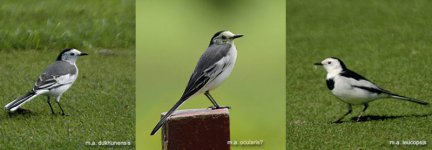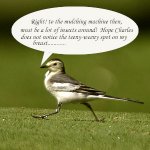Hi,
White Wagtails winter in the Kolkata (Calcutta) city area and the 1st lot is already in. I have noticed that a lot of them land together and then disperse over a few days.
This morning saw a large batch at my local golf club and interestingly there seemed to be 3 sub-species in attendance.
While dukhunensis is the regular visitor, leucopsis can also be seen. What puzzled me was the wagtail in the middle (attached image) with a thin but clearly visible eye-stripe. Is this "ocularis" or a juv./moulting dukhunensis?
Cheers!
Sumit
White Wagtails winter in the Kolkata (Calcutta) city area and the 1st lot is already in. I have noticed that a lot of them land together and then disperse over a few days.
This morning saw a large batch at my local golf club and interestingly there seemed to be 3 sub-species in attendance.
While dukhunensis is the regular visitor, leucopsis can also be seen. What puzzled me was the wagtail in the middle (attached image) with a thin but clearly visible eye-stripe. Is this "ocularis" or a juv./moulting dukhunensis?
Cheers!
Sumit





